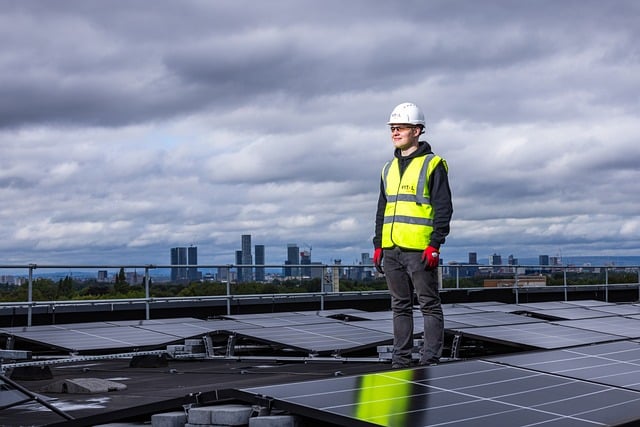“Empowering Solar Efficiency: Software-Driven Innovation in Modern Inverters.”
The role of software in modern solar inverters is pivotal in enhancing the efficiency, reliability, and functionality of solar energy systems. As the demand for renewable energy sources grows, solar inverters have evolved from simple power conversion devices to sophisticated systems that incorporate advanced software solutions. These software applications enable real-time monitoring, data analytics, and grid integration, allowing for optimized energy management and improved performance. Additionally, software plays a crucial role in ensuring compliance with regulatory standards, facilitating remote diagnostics, and enabling features such as smart grid connectivity and energy storage integration. As a result, the integration of software in solar inverters not only maximizes energy output but also contributes to the overall sustainability and resilience of solar power systems.
Software Optimization for Energy Efficiency in Solar Inverters
In the rapidly evolving landscape of renewable energy, solar inverters play a pivotal role in converting the direct current (DC) generated by solar panels into alternating current (AC) suitable for use in homes and businesses. However, the efficiency of this conversion process is not solely dependent on hardware; software optimization has emerged as a critical factor in enhancing energy efficiency in modern solar inverters. By leveraging advanced algorithms and real-time data analysis, software solutions can significantly improve the performance and reliability of solar energy systems.
One of the primary ways software contributes to energy efficiency is through maximum power point tracking (MPPT). This sophisticated algorithm continuously monitors the output of solar panels and adjusts the inverter’s operating point to ensure it extracts the maximum possible power under varying environmental conditions. For instance, as sunlight intensity fluctuates due to cloud cover or shading, the MPPT algorithm dynamically recalibrates the inverter’s settings, optimizing energy capture. This capability is essential, as even minor improvements in energy extraction can lead to substantial gains over time, particularly in regions with variable weather patterns.
Moreover, software optimization extends beyond just MPPT. Modern solar inverters are equipped with sophisticated monitoring systems that provide real-time data on energy production, system performance, and potential issues. This data is invaluable for both users and service providers, as it allows for proactive maintenance and troubleshooting. By analyzing performance trends, software can identify inefficiencies or malfunctions before they escalate into significant problems, thereby minimizing downtime and maximizing energy output. This predictive maintenance capability not only enhances the longevity of the inverter but also ensures that the solar energy system operates at peak efficiency.
In addition to real-time monitoring, software plays a crucial role in integrating solar inverters with smart grid technology. As the energy landscape shifts towards decentralized power generation, the ability to communicate and interact with the grid becomes increasingly important. Advanced software solutions enable solar inverters to respond to grid signals, adjusting their output based on demand and supply fluctuations. This capability not only helps stabilize the grid but also allows solar energy systems to participate in demand response programs, where users can receive financial incentives for reducing or shifting their energy consumption during peak periods. Consequently, this integration fosters a more resilient and efficient energy ecosystem.
Furthermore, the advent of machine learning and artificial intelligence in software development is revolutionizing the way solar inverters operate. These technologies can analyze vast amounts of data to identify patterns and optimize performance in ways that traditional algorithms cannot. For example, machine learning models can predict energy production based on historical weather data, allowing for better planning and energy management. This predictive capability can also enhance the user experience by providing insights into energy consumption patterns, enabling homeowners and businesses to make informed decisions about their energy use.
As the demand for renewable energy continues to grow, the role of software in solar inverters will only become more pronounced. The ongoing advancements in software optimization not only enhance the efficiency and reliability of solar energy systems but also contribute to the broader goal of achieving a sustainable energy future. By harnessing the power of software, we can unlock the full potential of solar energy, making it a more viable and attractive option for consumers and businesses alike. In this way, software optimization stands as a cornerstone of modern solar inverter technology, driving the transition towards a cleaner, more efficient energy landscape.
The Impact of Firmware Updates on Solar Inverter Performance

In the rapidly evolving landscape of renewable energy, solar inverters play a pivotal role in converting the direct current (DC) generated by solar panels into alternating current (AC) suitable for household use and integration into the power grid. However, the performance and efficiency of these inverters are not solely determined by their hardware; rather, software, particularly firmware, significantly influences their operation. Firmware updates have emerged as a critical component in enhancing the performance of solar inverters, ensuring they remain efficient, reliable, and capable of adapting to changing energy demands and grid conditions.
To begin with, firmware updates can optimize the operational algorithms of solar inverters, allowing them to maximize energy harvest from solar panels. As solar technology advances, new algorithms are developed to improve the efficiency of energy conversion and management. By regularly updating the firmware, inverter manufacturers can implement these algorithms, enabling inverters to respond more effectively to variations in sunlight and temperature. This adaptability not only enhances energy production but also extends the lifespan of the solar system by preventing potential overloading or underutilization of resources.
Moreover, firmware updates play a crucial role in enhancing the safety and reliability of solar inverters. As with any electronic device, vulnerabilities can emerge over time, making systems susceptible to malfunctions or even cyber threats. Manufacturers often release firmware updates to address these vulnerabilities, ensuring that the inverter operates securely and efficiently. By keeping the firmware up to date, users can protect their investment and ensure compliance with the latest safety standards, which is particularly important as regulatory requirements evolve in response to technological advancements.
In addition to performance and safety improvements, firmware updates can also facilitate better communication between solar inverters and other components of the solar energy system. Modern inverters are increasingly equipped with smart technology that allows them to communicate with energy management systems, battery storage solutions, and even the grid itself. Through firmware updates, manufacturers can enhance these communication protocols, enabling more efficient energy management and integration. This capability is particularly vital in a world where energy consumption patterns are becoming more dynamic, necessitating real-time adjustments to optimize energy use and reduce costs.
Furthermore, the impact of firmware updates extends beyond individual systems to the broader energy ecosystem. As more solar inverters are deployed, their ability to communicate and share data with the grid becomes increasingly important. Firmware updates can improve grid compatibility, allowing inverters to respond to grid signals and contribute to grid stability. This is particularly relevant in regions with high penetration of renewable energy sources, where managing supply and demand fluctuations is essential for maintaining grid reliability.
In conclusion, the role of firmware updates in solar inverters cannot be overstated. They are essential for optimizing performance, enhancing safety, improving communication, and ensuring compatibility with the evolving energy landscape. As the solar industry continues to grow and innovate, the importance of keeping inverter firmware up to date will only increase. For solar system owners, this means that regular maintenance and updates should be a priority, ensuring that their systems operate at peak efficiency and contribute effectively to a sustainable energy future. By embracing the advancements in software technology, stakeholders can harness the full potential of solar energy, driving the transition towards a cleaner, more resilient energy system.
Smart Monitoring Systems: Enhancing Solar Inverter Functionality
In the rapidly evolving landscape of renewable energy, solar inverters have emerged as pivotal components in the efficient conversion of solar energy into usable electricity. However, the functionality of these inverters extends far beyond mere energy conversion; it is increasingly intertwined with sophisticated software systems that enhance their performance and reliability. One of the most significant advancements in this domain is the integration of smart monitoring systems, which play a crucial role in optimizing the operation of solar inverters.
Smart monitoring systems are designed to provide real-time data on the performance of solar energy systems. By utilizing advanced software algorithms, these systems can track various parameters such as energy production, system efficiency, and environmental conditions. This data is invaluable for both system owners and operators, as it allows for immediate insights into how well the solar installation is performing. For instance, if a solar inverter is underperforming, the monitoring system can quickly identify the issue, whether it be shading from nearby trees, dirt accumulation on panels, or a malfunctioning component. This proactive approach to maintenance not only enhances the longevity of the solar system but also maximizes energy output.
Moreover, the role of software in smart monitoring systems extends to predictive analytics. By analyzing historical performance data, these systems can forecast potential issues before they arise. This predictive capability is particularly beneficial for large-scale solar installations, where downtime can lead to significant financial losses. By anticipating maintenance needs, operators can schedule repairs during off-peak times, thereby minimizing disruptions and ensuring a consistent energy supply. This level of foresight is made possible through sophisticated machine learning algorithms that continuously learn from the data collected, improving their accuracy over time.
In addition to performance monitoring and predictive maintenance, smart monitoring systems also facilitate enhanced user engagement. Many modern solar inverters come equipped with user-friendly interfaces that allow homeowners and businesses to access their energy data easily. This transparency empowers users to make informed decisions about their energy consumption and encourages energy-saving behaviors. For example, if a user notices that their energy production dips during certain times of the day, they may adjust their usage patterns accordingly, further optimizing their energy efficiency.
Furthermore, the integration of smart monitoring systems with mobile applications has revolutionized how users interact with their solar energy systems. These applications provide users with instant access to performance metrics, alerts, and maintenance reminders, all from the convenience of their smartphones. This level of accessibility not only enhances user experience but also fosters a deeper connection between individuals and their renewable energy systems, promoting a culture of sustainability.
As the solar industry continues to grow, the importance of software in enhancing the functionality of solar inverters cannot be overstated. Smart monitoring systems represent a significant leap forward in the ability to manage and optimize solar energy production. By providing real-time insights, predictive analytics, and user-friendly interfaces, these systems ensure that solar inverters operate at peak efficiency while also engaging users in their energy journey. As technology advances, we can expect even more innovative solutions that will further enhance the capabilities of solar inverters, solidifying their role as essential components in the transition to a sustainable energy future. In this context, the synergy between hardware and software will be crucial in driving the solar industry forward, ensuring that it meets the growing energy demands of our world while minimizing environmental impact.
The Future of AI and Machine Learning in Solar Inverter Technology
As the solar energy sector continues to evolve, the integration of artificial intelligence (AI) and machine learning into solar inverter technology is poised to revolutionize the way we harness and manage solar power. The future of solar inverters is not merely about converting direct current (DC) from solar panels into alternating current (AC) for use in homes and businesses; it is increasingly about optimizing performance, enhancing efficiency, and ensuring reliability through advanced software solutions. This shift is driven by the need for smarter energy management systems that can adapt to changing conditions and user demands.
One of the most significant advancements in solar inverter technology is the ability to utilize AI algorithms to predict energy production and consumption patterns. By analyzing historical data and real-time inputs, these algorithms can forecast solar generation based on weather conditions, time of day, and seasonal variations. This predictive capability allows for better energy management, enabling users to optimize their energy consumption and reduce reliance on the grid. As a result, homeowners and businesses can achieve greater energy independence while minimizing costs.
Moreover, machine learning enhances the operational efficiency of solar inverters by enabling them to learn from their performance over time. By continuously analyzing data from various sensors and operational metrics, these systems can identify inefficiencies and suggest adjustments to improve overall performance. For instance, if a particular inverter consistently underperforms during specific weather conditions, machine learning algorithms can recommend operational changes or maintenance actions to mitigate these issues. This proactive approach not only extends the lifespan of the equipment but also maximizes energy output, ultimately leading to higher returns on investment for solar system owners.
In addition to performance optimization, AI and machine learning play a crucial role in predictive maintenance. Traditional maintenance schedules often rely on fixed intervals, which can lead to unnecessary downtime or, conversely, missed opportunities for timely repairs. By leveraging data analytics, solar inverters equipped with AI can monitor their own health and predict potential failures before they occur. This capability allows for targeted maintenance interventions, reducing costs and minimizing disruptions in energy production. As a result, operators can maintain a more reliable and efficient solar energy system.
Furthermore, the integration of AI in solar inverter technology enhances grid stability and resilience. As more renewable energy sources are connected to the grid, managing fluctuations in energy supply and demand becomes increasingly complex. Smart inverters equipped with AI can communicate with the grid to provide real-time data on energy production and consumption, facilitating better load balancing and reducing the risk of outages. This dynamic interaction not only supports the integration of renewable energy but also contributes to a more sustainable and reliable energy infrastructure.
Looking ahead, the potential for AI and machine learning in solar inverter technology is vast. As these technologies continue to advance, we can expect even more sophisticated algorithms that will further enhance energy management capabilities. Innovations such as decentralized energy management systems, where individual inverters communicate with one another and with the grid, could lead to a more resilient and efficient energy ecosystem. Additionally, as the cost of AI technology decreases, its adoption in solar inverters will likely become more widespread, making advanced energy management accessible to a broader range of users.
In conclusion, the future of solar inverter technology is inextricably linked to the advancements in AI and machine learning. These technologies are not only transforming how solar energy is generated and consumed but are also paving the way for a more sustainable and efficient energy landscape. As we continue to embrace these innovations, the role of software in solar inverters will undoubtedly become more critical, driving the transition toward a cleaner and more resilient energy future.
Q&A
1. **Question:** What is the primary function of software in modern solar inverters?
**Answer:** The primary function of software in modern solar inverters is to optimize energy conversion from solar panels to usable electricity, ensuring maximum efficiency and performance.
2. **Question:** How does software enhance the monitoring capabilities of solar inverters?
**Answer:** Software enhances monitoring capabilities by providing real-time data on energy production, system performance, and potential faults, allowing for proactive maintenance and troubleshooting.
3. **Question:** In what way does software contribute to grid integration for solar inverters?
**Answer:** Software facilitates grid integration by managing power output, ensuring compliance with grid regulations, and enabling features like demand response and frequency regulation.
4. **Question:** What role does software play in the safety features of modern solar inverters?
**Answer:** Software plays a crucial role in safety features by implementing protective measures such as anti-islanding, overvoltage protection, and fault detection to prevent damage to the inverter and the grid.
Conclusion
Software plays a crucial role in modern solar inverters by enhancing their efficiency, reliability, and functionality. It enables advanced features such as real-time monitoring, grid management, and predictive maintenance, allowing for optimal energy conversion and integration with smart grid technologies. Additionally, software facilitates user-friendly interfaces for system management and data analysis, contributing to improved performance and user experience. Overall, the integration of sophisticated software in solar inverters is essential for maximizing energy output, ensuring compliance with regulatory standards, and supporting the transition to renewable energy sources.




